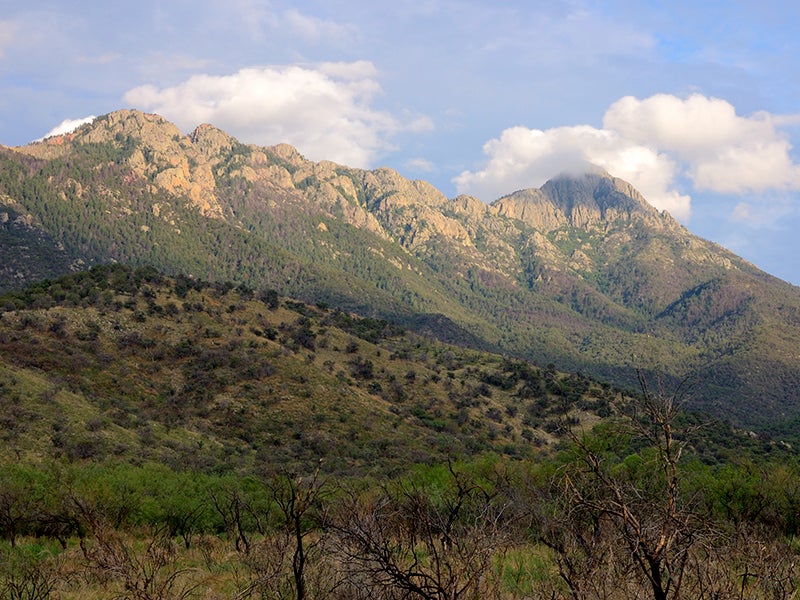Tribes Challenge Forest Service Approval for Toxic Open-pit Copper Mine on Sacred Lands
Mine would desecrate burial sites and historic places, and destroy streams and groundwater resources
Contact
The Tohono O’odham Nation, the Pascua Yaqui Tribe and the Hopi Tribe filed a complaint in U.S. District Court today challenging the approval by the U.S. Forest Service of a plan by Hudbay Minerals Inc. of Canada to develop a sprawling toxic open pit copper mine on public land. The tribes are represented by Earthjustice, a non-profit environmental law firm.
The proposed Rosemont Copper Mine would be located about 30 miles south of Tucson in the Santa Rita Mountains, a place of great cultural and ecological significance. The tribes, representing more than 50,000 enrolled members, have resided in this region since time immemorial and have a deep connection to the land and wildlife. The proposed mine site lies within the tribes’ ancestral homelands and contains numerous sacred sites, ancestral villages and burial grounds. The mine site is also home to the endangered jaguar, an animal of spiritual significance to the tribes.
The proposed mine, to be developed by Hudbay Minerals Inc., would be devastating to these cultural and natural values. The mine would transform 3,653 acres of National Forest land that is publicly-owned and of important cultural and religious significance to the tribes into an industrial mining zone. The mine would require the excavation of an open pit over a mile wide and a half-mile deep to be served by roads, ore processing facilities, and groundwater pumping. The pit will be surrounded by waste piles containing over a billion tons of waste rock and tailings.
The Forest Service admits that the damage to cultural resources would be “severe, irreversible and irretrievable.” It would destroy 82 historic places and desecrate at least 31 known gravesites, though numerous others are likely to be discovered during the excavation process. Despite these impacts, the Forest Service approved the Final Environmental Impact Statement last June to allow the mine to proceed.
In total, a dozen Arizona tribes have expressed concerns with this mine project, participating in meetings, public hearings, consultations. The Tohono O’odham and Pascua Yaqui Tribes have passed formal resolutions of opposition in 2009 and 2013, respectively. The Tohono O’odham Nation also produced a short film, Ours is the Land, which details the significance of Ce:wi Duag (Santa Rita Mountains) and the irreparable harm the mine would cause.
“Ours is the Land” is produced by the Tohono O’odham Nation from Rogelio Garcia on Vimeo.
“The Rosemont Copper project would destroy cultural and archeological sites on our traditional lands, including the graves of our ancestors,” said Tohono O’odham Nation Chairman Edward D. Manuel. “Consider what it would be like if a foreign company proposed excavating Arlington National Cemetery. All Americans treasure this cemetery, just like our tribes treasure the land this mine will desecrate.”
Pascua Yaqui Tribe Chairman Robert Valencia said, “The proposed Rosemont Copper Mine would defile our heritage, and it also threatens our future. The mine would destroy lands, animals, and plants that have great spiritual significance to us. And, its impacts to our region’s groundwater resources poses a danger that will long outlast any mining operations.”
“The Hopi Tribe continues to hope that someday a Forest Service supervisor’s decision will reflect the Forest Service’s listening to tribes regarding Sacred Sites and Traditional Cultural Properties, respect the natural water, wildlife, and night sky values of the tribes, and assist the Forest Service in emerging from the 19th century into the 21st,” said Hopi Tribe Vice Chairman Clark W. Tenakhongva.
The mine also would cause permanent damage to precarious groundwater resources in the arid region. Seeps and springs which are not only sacred to the tribes but also support native plants and wildlife, would be depleted. After the copper is gone and the company abandons the mine, a toxic lake would form in the pit, creating a hydraulic sink that will deplete streams, collect polluted runoff and siphon water from the regional aquifer. This toxic lake will never be reclaimed or remediated.
“This mine will have devastating impacts on sacred lands long used by the tribes for prayer, ceremonies, and to connect with their past and their ancestors,” said Heidi McIntosh, an attorney with Earthjustice. “The Forest Service should have rejected Hudbay’s request to use these sacred lands as a dumping ground for toxic waste rock, mine tailings, and processing plants. Instead, the Forest Service bowed to the mining company and then denied it had the authority to protect this uniquely important place. We’re asking the Court to right this injustice.”
The complaint is based on the Forest Service’s violations of the Forest Service Organic Act, the National Environmental Policy Act, and the National Historic Preservation Act. The tribes are asking the Court to reverse the Forest Service’s decision and enjoin construction of the mine.

Additional Resources
About Earthjustice
Earthjustice is the premier nonprofit environmental law organization. We wield the power of law and the strength of partnership to protect people's health, to preserve magnificent places and wildlife, to advance clean energy, and to combat climate change. We are here because the earth needs a good lawyer.